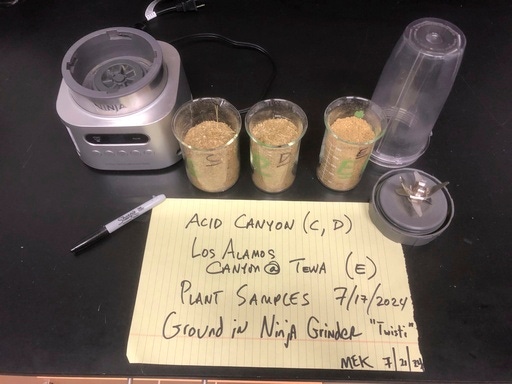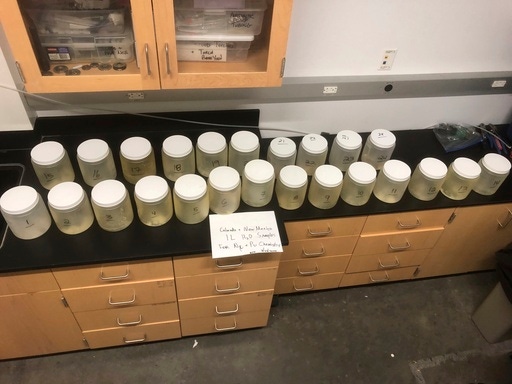Watchdogs want US to address extreme plutonium contamination in Los Alamos’ Acid Canyon

This July 21, 2024, image provided by Michael Ketterer shows vegetation from Acid Canyon and lower Los Alamos Canyon near Los Alamos, N.M., after being milled as part of a sampling project. (Michael Ketterer via AP)[ASSOCIATED PRESS/Michael Ketterer]
ALBUQUERQUE, N.M. (AP) — Watchdogs are raising new concerns about legacy contamination in Los Alamos, the birthplace of the atomic bomb and home to a renewed effort to manufacture key components for nuclear weapons.
A Northern Arizona University professor emeritus who analyzed soil, water and vegetation samples taken along a popular hiking and biking trail in Acid Canyon said Thursday that there were more extreme concentrations of plutonium found there than at other publicly accessible sites he has researched in his decades-long career.
That includes land around the federal government’s former weapons plant at Rocky Flats in Colorado.
While outdoor enthusiasts might not be in immediate danger while traveling through the pine tree-lined canyon, Michael Ketterer — who specializes in tracking the chemical fingerprints of radioactive materials — said state and local officials should be warning people to avoid coming in contact with water in Acid Canyon.
“This is an unrestricted area. I’ve never seen anything quite like it in the United States,” the professor told reporters. “It’s just an extreme example of very high concentrations of plutonium in soils and sediments. Really, you know, it’s hiding in plain sight.”
Ketterer teamed up with the group Nuclear Watch New Mexico to gather the samples in July, a rainy period that often results in isolated downpours and stormwater runoff coursing through canyons and otherwise dry arroyos. Water was flowing through Acid Canyon when the samples were taken.
The work followed mapping done by the group earlier this year that was based on a Los Alamos National Laboratory database including plutonium samples from throughout the area.
The U.S. Department of Energy’s Environmental Management Los Alamos Field Office said Thursday said in a statement to The Associated Press that the information presented by Ketterer and Nuclear Watch is consistent with department data that has been publicly available for years and that the canyon remains safe for unrestricted use.
The field office “continues to collect and monitor sediment and water samples in the Acid Canyon area and the results have consistently shown the levels of plutonium remain very low and well within the safe exposure ranges,” it said.
Jay Coghlan, director of Nuclear Watch, said plutonium contamination in the heart of Los Alamos is a concern, particularly as the lab — under the direction of Congress, the Energy Department and the National Nuclear Security Administration — gears up to begin producing the next generation of plutonium pits for the nation’s nuclear arsenal.
He pointed to Acid Canyon as a place where more comprehensive cleanup should have happened decades ago.
“Cleanup at Los Alamos is long delayed,” Coghlan said, adding that annual spending for the plutonium pit work has neared $2 billion in recent years while the cleanup budget for legacy waste is expected to decrease in the next fiscal year.
From 1943 to 1964, liquid wastes from nuclear research at the lab was piped into the canyon, which is among the tributaries that eventually pass through San Ildefonso Pueblo lands on their way to the Rio Grande.
The federal government began cleaning up Acid Canyon in the late 1960s and eventually transferred the land to Los Alamos County. Officials determined in the 1980s that conditions within the canyon met DOE standards and were protective of human health and the environment.
The environmental management field office pointed to a 2018 DOE study that estimated the radiation dose to a person who might recreate in the canyon is less than 0.1 millirem per year. According to the U.S. Nuclear Regulatory Commission, the annual average dose per person from all natural and man-made sources is about 620 mrems.
Ketterer and Coghlan said the concerns now are the continued downstream migration of plutonium, absorption by plants and the creation of contaminated ash following wildfires.
Ketterer described it as a problem that cannot be fixed but said residents and visitors would appreciate knowing that it’s there.
“It really can’t be undone,” he said. “I suppose we could go into Acid Canyon and start scooping out a lot more contaminated stuff and keep doing that. It’s kind of like trying to pick up salt that’s been thrown into a shag carpet. It’s crazy to think you’re going to get it all.”
Copyright 2024 The Associated Press. All rights reserved. This material may not be published, broadcast, rewritten or redistributed without permission.
